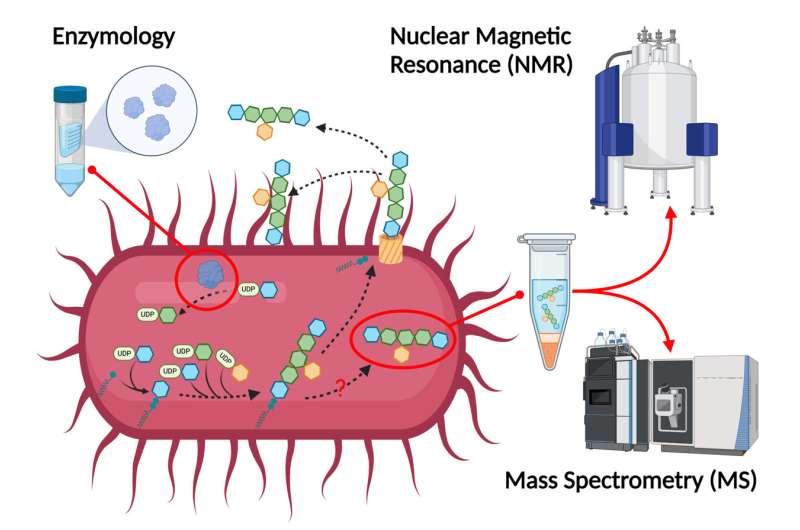
b-Cool formation requires different sugar building blocks, which are depicted as colored hexagons. Specific enzymes link each sugar in a precise manner to form a membrane-anchored glycan (green zigzag). The glycan is likely transported outside the cell to carry out its activity during the early steps of disease progression. The researcher studied the functions of enzymes involved in the formation of b-Cool and analyzed the composition and structure of b-Cool using nuclear magnetic resonance (NMR) and mass spectrometry (MS). Credit: Yang Su, University of Georgia in Athens; created with BioRender.com
Researchers have identified a new complex-carbohydrate biomolecule, or glycan, that plays a key role in the nasal colonization of the Bordetella bacteria responsible for whooping cough. The discovery could make it possible to create a new drug or vaccine that interferes with the glycan to greatly reduce or even stop ongoing Bordetella transmission.
Bordetella pertussis is the cause of the respiratory infection pertussis, which is widely known as whooping cough. Today’s pertussis vaccines keep people from getting severely sick, but they don’t eliminate the bacteria because it excels at colonizing, growing and persisting inside the nose. This means that despite more than 99% of people being vaccinated in the U.S., whooping cough continues to spread, leading to infections among vulnerable populations, particularly infants and elderly people.
Yang Su led the study at the University of Georgia in Athens.
“Our newly discovered glycan is crucial for the bacteria to maintain its ability to efficiently colonize the nose and transmit to a new host,” said Su, a doctoral candidate in the department of biochemistry and molecular biology. “By understanding the biochemical and molecular function of genes and enzymes involved in its formation, we can now intervene in the production of this glycan.”
Su will present the research at Discover BMB, the annual meeting of the American Society for Biochemistry and Molecular Biology, which will be held March 23–26 in San Antonio. He is co-advised by Maor Bar-Peled and Eric T. Harvill, both from the University of Georgia, and collaborates with Andrew Preston from the University of Bath in the UK and Thomas M. Krunkosky from the University of Georgia.

Despite widespread vaccination against whooping cough, the Bordetella bacteria continues to spread and infect vulnerable populations. A newly discovered Bordetella glycan, named b-Cool, was found to have a key role in nasal colonization. Developing new drugs or vaccines that halt b-Cool production or function may offer new ways to combat the disease. Credit: Yang Su, University of Georgia in Athens; created with BioRender.com
“My multidisciplinary approach integrates enzymology, glycan structural analyses, genetics, airway cell models and mouse infection models,” said Su. “To my knowledge, this is the first report of a glycan that is significant for the early colonization in the nose of its host.”
Glycans are biomolecules made of chains of carbohydrates such as polysaccharides. They are essential in various biological processes, including cell–cell recognition, signaling and immune response modulation.
In a previous study, the researchers discovered that a glycan known as transmission extracellular polysaccharide (tEPS) was required for Bordetella to spread among hosts. They then discovered that the production of tEPS glycan was related to another group of genes. The investigators suspected that this new group of genes likely produced another glycan, but nothing was known about its function or structure.
In the new work, the researchers eliminated the genes that expressed this unknown glycan from bacteria to see if they could uncover its function. The resulting Bordetella mutant showed a 70% reduction in its ability to colonize the nose of mice within six hours of inoculation. The mutant also showed a significantly reduced ability to transmit from the original host to a new host.

The researchers used mouse airway cell models (epithelia culture) and a mouse colonization model to uncover the function of the b-Cool glycan in the nasal colonization of Bordetella. Credit: Yang Su, University of Georgia in Athens; created with BioRender.com
The researchers discovered that this new glycan, which they named Bordetella colonization oligosaccharide, or b-Cool, is found in multiple Bordetella species, including those infecting dogs and other animals, as well as in strains of Bordetella pertussis isolated from patients. This suggests that targeting b-Cool could lead to the development of vaccines and medications that would be effective against both animal and human infections.
The researchers are now working to understand how b-Cool mediates Bordetella colonization in the nose, information that will help develop therapeutics that interfere with colonization. They are also developing a vaccine that targets the b-Cool glycan, which they plan to test in various hosts.
Yang Su will present this research during a poster session from 4:30 to 6:30 p.m. CDT on Monday, March 25, in the exhibit hall of the Henry B. González Convention Center (Poster Board No. 288) .
Citation:
Researchers uncover key biomolecule involved in whooping cough infection (2024, March 25)
retrieved 26 March 2024
from https://phys.org/news/2024-03-uncover-key-biomolecule-involved-whooping.html
This document is subject to copyright. Apart from any fair dealing for the purpose of private study or research, no
part may be reproduced without the written permission. The content is provided for information purposes only.
>>> Read full article>>>
Copyright for syndicated content belongs to the linked Source : Phys.org – https://phys.org/news/2024-03-uncover-key-biomolecule-involved-whooping.html































